Until not long ago, two-way communication was thought to be an exclusively human trait. But a new study shows just flawed this idea was, reporting that many animals from elephants to mosquitoes employ turn-taking behavior when communication among themselves. The findings might one day help scientists pinpoint the origin of human speech.

An international team of researchers reviewed the current scientific literature on animal communication. From the hundreds of studies that they analyzed spanning over 50 years of research, the authors found that the orderly exchange of communicative signals is far more common in the animal kingdom than anyone thought.
The challenge lied in piecing together all the fragmented information from all the various studies published thus far, whether the focus was on the chirps of birds or the whistles of dolphins. But once this task was complete, the researchers were impressed to learn about how complex animal communication really is.
Take timing, for instance, which is a key feature of communicative turn-taking in both humans and non-human animals. In some species of songbird, the latency between notes produced by two different birds is less than 50 milliseconds. On the other end of the spectrum, sperm whales exchange sequences of clicks with a gap of about two seconds between turns. We, humans, lie somewhere in the middle, producing utterances with gaps of around 200 milliseconds between turns.
Interestingly, us humans aren’t the only species that consider it rude to interrupt. The researchers found that both black-capped chickadees and European starlings practiced so-called “overlap avoidance” during turn-taking communication. If an overlap occurred, individuals would go silent or flew away, a sign that overlapping may be seen as an unacceptable violation of the social rules of turn-taking.
Although temporal coordination in animal communication has attracted interest over several decades, no clear picture has yet emerged as to why individuals exchange signals, the researchers wrote.
It’s quite likely that this turn-taking behavior underlies the evolution of human speech so a more systematic cross-species examination could render striking results. The authors even offer a framework that might enable such a comparison.
“The ultimate goal of the framework is to facilitate large-scale, systematic cross-species comparisons,” Dr. Kobin Kendrick, from the University of York’s Department of Language and Linguistic Science and one of the authors of the new study, said in a statement.
“Such a framework will allow researchers to trace the evolutionary history of this remarkable turn-taking behavior and address longstanding questions about the origins of human language.”
The team included researchers from the Universities of York and Sheffield, the Max Planck Institute for Evolutionary Anthropology in Germany, and the Max Planck Institute for Psycholinguistics in the Netherlands.
“We came together because we all believe strongly that these fields can benefit from each other, and we hope that this paper drives more cross-talk between human and animal turn-taking research in the future,” said Dr. Sonja Vernes, from the Max Planck Institute for Psycholinguistics.
Scientific reference: Taking turns: Bridging the gap between human and animal communication, Proceedings of the Royal Society B.


